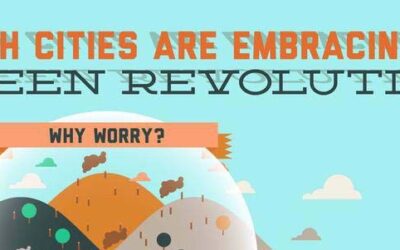Environmental Infographics
What Is Your Greatest Footprint? (Carbon vs Water)
The average Irish citizen creates 4,855 cubic metres of CO2E per year. They also use 1,301 cubic metres of water per year, making their carbon footprint 3.75 times as big as their water footprint. This infographic from Calor Gas looks at ways to try and reduce these.
50 Unbelievable Facts About Earth
You may have lived on Earth all your life, but how much do you really know about it? Did you know that Earth is the only planet in the Solar System with plate tectonics, or that the continents move 2cm every year? For more fascinating facts check out this infographic by Giraffe Childcare.
Rainforest Facts
This infographic, created by Oakfurniture UK, provides all important facts you need to know about the worlds rainforests including information on why they are disappearing.
E-Waste Explosion: A Growing Concern
In 2010, the United States disposed of some 2,439,000 tons of waste generated from electronic devices. 649,000 of these tons were recycled, while an astounding 1,790,000 were thrown in landfills or incinerated. These disused electronics have come to be referred to colloquially as “E-Waste.”
Solar Energy – Social and Economic Win Win for Canada
This infographic shows why the clean and renewable energy path is a better choice for Canadians than the traditional path. Learn how investing in Canada’s most abundant resource, sun, could result in more skilled jobs and better economic growth.
Which Cities Are Embracing the Green Revolution?
With a growing awareness of the myriad of threats now facing modern society, an increasing emphasis is being placed on policies of sustainability, environmental protection, and green living. This infographic looks at what six of the world’s largest cities are doing in the name of going green.
The Age-Old Battle: Star Wars vs. Star Trek
The battle wages on – that is between two of sci-fi’s most iconic franchises, Star Trek and Star Wars. It is s a battle that has been discussed by fans for over 30 years now. And with the recent news of J.J. Abrams accepting the director’s job on the next Star Wars film, the flames have been fanned.
The Importance of Civil Engineering in Natural Disaster Preparedness and Recovery
From developing technologies to help make building infrastructures stronger to the reconstruction efforts after a natural disaster, Civil Engineers play a crucial role in our society before and after hurricanes, tornados, floods, earthquakes, and blizzards.
Why Build Green?
Green building is smart building. Aside from their obvious benefit to the environment, green buildings deliver financial savings, are more comfortable, healthier, return higher productivity rates and have higher resale values. See this infographic for a quick look at why building green makes so much sense.
Going Green: Why Construction Sites Should Recycle
It’s no secret that construction projects produce a lot of waste. If your firm practices smart waste management, you can recycle asphalt, concrete, plastics, glass, and much more. This infographic from Rent Dumpsters has more information about recycling and its benefits.
What Is Your Greatest Footprint? (Carbon vs Water)
The average Irish citizen creates 4,855 cubic metres of CO2E per year. They also use 1,301 cubic metres of water per year, making their carbon footprint 3.75 times as big as their water footprint. This infographic from Calor Gas looks at ways to try and reduce these.
50 Unbelievable Facts About Earth
You may have lived on Earth all your life, but how much do you really know about it? Did you know that Earth is the only planet in the Solar System with plate tectonics, or that the continents move 2cm every year? For more fascinating facts check out this infographic by Giraffe Childcare.
Rainforest Facts
This infographic, created by Oakfurniture UK, provides all important facts you need to know about the worlds rainforests including information on why they are disappearing.
E-Waste Explosion: A Growing Concern
In 2010, the United States disposed of some 2,439,000 tons of waste generated from electronic devices. 649,000 of these tons were recycled, while an astounding 1,790,000 were thrown in landfills or incinerated. These disused electronics have come to be referred to colloquially as “E-Waste.”
Solar Energy – Social and Economic Win Win for Canada
This infographic shows why the clean and renewable energy path is a better choice for Canadians than the traditional path. Learn how investing in Canada’s most abundant resource, sun, could result in more skilled jobs and better economic growth.
Which Cities Are Embracing the Green Revolution?
With a growing awareness of the myriad of threats now facing modern society, an increasing emphasis is being placed on policies of sustainability, environmental protection, and green living. This infographic looks at what six of the world’s largest cities are doing in the name of going green.
The Age-Old Battle: Star Wars vs. Star Trek
The battle wages on – that is between two of sci-fi’s most iconic franchises, Star Trek and Star Wars. It is s a battle that has been discussed by fans for over 30 years now. And with the recent news of J.J. Abrams accepting the director’s job on the next Star Wars film, the flames have been fanned.
The Importance of Civil Engineering in Natural Disaster Preparedness and Recovery
From developing technologies to help make building infrastructures stronger to the reconstruction efforts after a natural disaster, Civil Engineers play a crucial role in our society before and after hurricanes, tornados, floods, earthquakes, and blizzards.
Why Build Green?
Green building is smart building. Aside from their obvious benefit to the environment, green buildings deliver financial savings, are more comfortable, healthier, return higher productivity rates and have higher resale values. See this infographic for a quick look at why building green makes so much sense.
Going Green: Why Construction Sites Should Recycle
It’s no secret that construction projects produce a lot of waste. If your firm practices smart waste management, you can recycle asphalt, concrete, plastics, glass, and much more. This infographic from Rent Dumpsters has more information about recycling and its benefits.
Search 12,000+ Infographics!
Partners
Browse Archives By Category
Animated Infographics
Business Infographics
Career & Jobs Infographics
Education Infographics
Entertainment Industry Infographics
Environmental Infographics
Finance & Money Infographics
Food & Drink Infographics
Health Infographics
Historical Infographics
Home & Garden Infographics
Internet Infographics
Law and Legal Infographics
Lifestyle Infographics
Marketing Infographics
Offbeat Infographics
Parenting Infographics
Pets & Animals Infographics
Political Infographics
Shopping Infographics
Sports and Athletic Infographics
Technology Infographics
Transportation Infographics
Travel Infographics
Video Infographics












